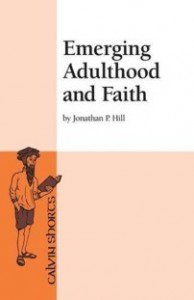Headlines scream … Ex-Christians, Young Adults Leaving the Faith, A Generation of Dropouts, Quitting Church, the Rise of the Nones. We are on the verge of a crisis with faith and the faithful in retreat. Could we be the last Christian generation? We must rally the troops, cut our losses, and tackle the problem.
 Jonathan P. Hill, Assistant Professor of Sociology at Calvin College recently published a short book Emerging Adulthood and Faith that explores the change (or absence of change) in the religious faith of young adults, the so-called generation Y or Millennials who were born roughly from 1980-2000. Much has been written of late decrying the loss of a generation, with the explicit or implicit assumption that the experience and trajectory of Millennials is unique.
Jonathan P. Hill, Assistant Professor of Sociology at Calvin College recently published a short book Emerging Adulthood and Faith that explores the change (or absence of change) in the religious faith of young adults, the so-called generation Y or Millennials who were born roughly from 1980-2000. Much has been written of late decrying the loss of a generation, with the explicit or implicit assumption that the experience and trajectory of Millennials is unique.
But do we have such a catastrophic problem?
Hill, like many other sociologists, argues that we need to take a closer look at hard data. Only then will we make good decisions for the right reasons. Bluntly: We need the facts. Hill’s book is a valuable fact-based resource for anyone involved in church leadership, from lead pastor to youth pastor to elder. Less than a hundred pages and very readable.
First, we need to frame the problem.
At any given moment, age differences between people can be the result of what demographers refer to as age, period, and cohort effects. (p. 7)
Some changes depend on stage of life. In many respects those who are 20 today reflect the same trends and attitudes as those who were 20 in the 50’s, 70’s and 90’s. For instance the elderly pray more than the young. In 1983 42% of those 18-29 reported daily prayer compared with 68% of those 70 and above. In 2012 the numbers were 39% and 71%. This isn’t a generational change; it depends more significantly on biological age and stage of life.
Some changes depend on period – historical shifts, cultural transformations that cut across generations. These events have a significant event on everyone alive at the time, both old and young. The reformation was a historical shift; the great depression and World War II are other examples.
Other changes are generational or cohort effects. These can be significant, but it is important to separate them from effects depending on stage of life and from larger cultural transformations. Bad information will lead to bad responses.
Second, we need to consider the source. There is power in stories, but anecdotal data will only deliver part of the picture. Individual stories always focus down to a specific social context and experience.
Good social science allows us to take a step back from our own experiences, providing data that can give us glimpses of powerful social forces we would otherwise be blinded to. These forces are the background to our lives, though we are often unaware of their influence. Social science can help us see these contexts. (p. 10)
It is important to consider both stories and survey data. In his book Hill focuses on survey data to consider three big issues: the religious identity of young people, the influence of higher education, and the influence of science on faith. He doesn’t disregard stories, but looks at the data that provide a larger context for the individual stories.
Is the religious identity of young adults changing? Certainly the data tell us that “somewhere between 50 and 70 percent of teenagers who were regularly in church on Sunday morning are no longer attending by their early twenties.” (p. 15) In fact, the drop in attendance begins at ages younger than 15 and levels out around 18 or 19. But much of this is a trend based on biological age. This isn’t a cohort or generational effect. About 12-13 percent of 18-29 year olds attend a Protestant church every week, a number that has been remarkably steady for the last forty years! Similarly about 42% of 18-29 year olds pray at least daily – a number that has been remarkably steady for the last forty years. There has been a significant change with the rise of “nones,” but this comes from those who were less committed to begin with. There has been a significant drop in those who attend services occasionally or who pray occasionally and a concomitant rise in those who never attend and never pray.
At least among Protestants, every concerned parent and pastor should know this: The percentage of young people with a strong Protestant identity, and the percentage who regularly practice their faith publicly and privately has barely budged over the past forty years. They are in your churches, youth groups, and Bible studies. Yes, something has been happening at the margins, but the center has held. (p. 20)
To me this suggests that we don’t need massive institutional transformations. We need to continue engaging people, families, young and old, in strong Christian community.
There is no evidence that Millennials are “drastically different from previous generations” except that those loosely affiliated with religious identity are now willing to drop it altogether. There is little social advantage to maintaining this kind of religious identity.
 Is secular college education a threat to faith? Bluntly, the answer is no, but there is a generational element to this one.
Is secular college education a threat to faith? Bluntly, the answer is no, but there is a generational element to this one.
While stories of individual faith loss are real and deserve our attention, there is little evidence of widespread disaffection from the faith as a result of secular higher education. (p. 29)
When college graduates are compared to the general population a different trend appears.
College graduates are actually more likely to practice their faith and say it is important in their daily life. They are no more likely to disaffiliate from a religious faith, although they do appear more likely to shy away from exclusivist claims about the Bible and more prone to switch to a mainline Protestant denomination. (p. 30)
Hill digs deeper and compares those with and without a college education, controlling for religious affiliation as younger teenagers. In the past college education did have an influence on secularization, but this isn’t true for the millennials. At last a distinction, but it isn’t negative.
Overall college graduation has a positive correlation with regular participation in a church, perhaps because college graduates have more faith in institutions than those who have never attended college.
Hill also finds that evangelical colleges and universities are doing a good job of nurturing faith. “On every measure of religious practice and identity, individuals attending evangelical Protestant colleges decline considerably less than their counterparts at other schools.” (p. 50) For example, at evangelical Protestant schools 73% of students who prayed regularly continue to do so, a number that drops to 56% at public schools. This probably results both from the curricular and social environment of the schools and from the family commitments and support experienced by these students.
Does education in science drive young people from the faith? Again the aggregate answer is no. Surprisingly, education in science in general and evolution in particular seems to have little effect on faith commitments. (As a science professor I cringe at this one – student form their views on “touchy” issues based on things other than the evidence.) And certainly there are plenty of stories of people struggling with these issues and changing their views. Hill doesn’t disregard or discount these (after all, the NSYR survey indicated that some 40 percent of young people with creationist views in 2002-3 did change their views by 2007-8, whether they go to college or not). But science education seems to have a minor influence one positions most people take.
People come to accept or reject evolution not as a result of pouring over the details and evidence, but as a symbolic gesture to indicate to others where they belong in the socio-political landscape. This requires understanding that religious beliefs, and beliefs about other contentious public issues, are intertwined with identity and social relationships. Formal science education, for most young people, is unlikely to change this. (p. 57)
Those who enter college with particular views concerning evolutionary biology are likely to retain them throughout the experience. The more tightly these views are coupled to social identity, the more tightly they will be held by most. This can be a wrenching experience for some who do find their views changing – to conflict with their social community, but it isn’t a widespread crisis for the church.
Does this outline of emerging adults surprise you?
Where should leaders in the church be concentrating effort to maintain a nurturing environment (i.e. a disciple making environment)?
If you wish to contact me directly you may do so at rjs4mail [at] att.net.
If interested you can subscribe to a full text feed of my posts at Musings on Science and Theology.











